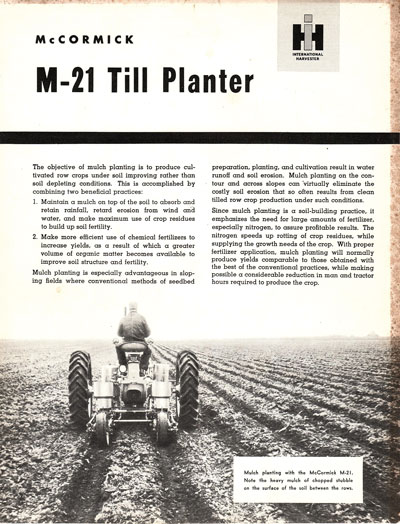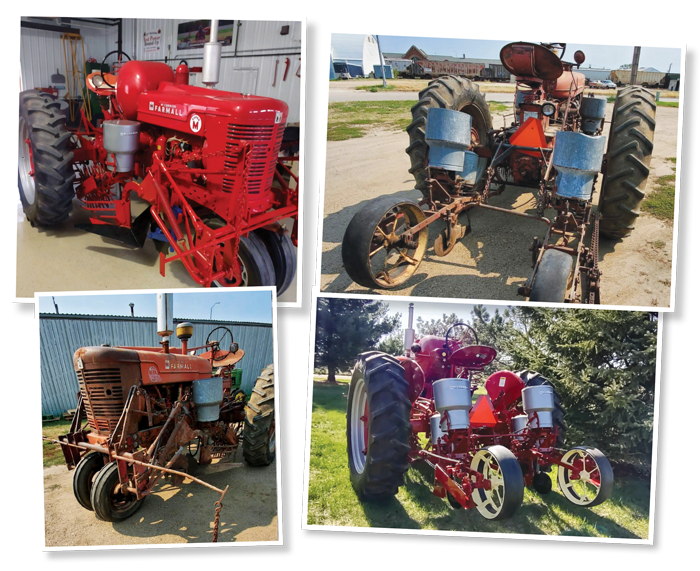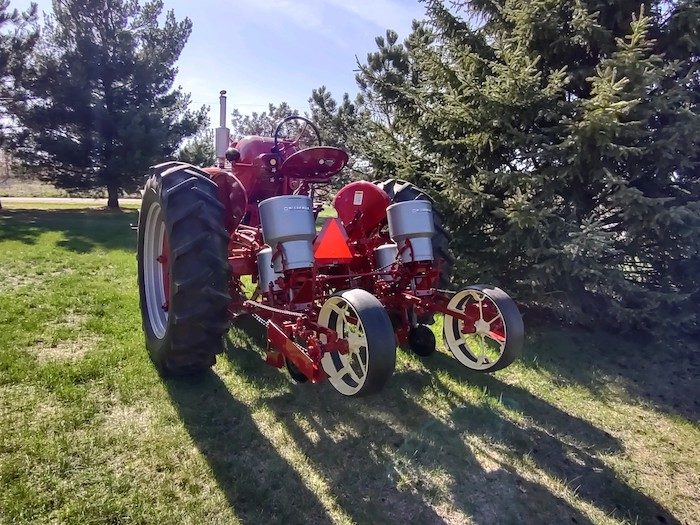I’ll go back to the beginning. The M-21 Till Planter, what many consider to be the world’s first commercial no-till planter, was originally built from 1952-55. 50 units were built, and it’s believed that only 23 were sold. They were 10-15 years ahead of their time because there was no herbicide out to control weeds. Allis Chalmers eventually came out with what is more widely accepted as the first commercially successful no-till planter in 1966. The key word there is “successful.”
This particular M-21 till planter was purchased new from A.L. Vicker Implement, the International Harvester dealer in Claremont, S.D., in 1954 by Robert Schuller, a progressive farmer from the area.
Robert participated in the South Dakota State College Corn Performance Test in 1955, 1956 and 1957. Back then, the college ran the test plots for corn yields, which were planted on Robert’s farm north of Claremont.
The original owner’s manual for the planter shows Robert’s handwritten notes detailing which seed plates were used and the sprocket settings for both corn and soybeans in 1955. He planted corn 9.75 inches apart and soybeans 3.5 inches apart on 40-inch rows.
“You can restore tractors every day if you want to, but this was something special...…”
Fast forward a couple years, and Darrell Jansen, the owner of a local International Harvester and later John Deere dealership, remembered the M-21 till planter on the Schuller farm and decided to ask if it was still around. He later acquired it, mounted it on a tractor and put it out in front of his John Deere lot to show everyone that IH was the first to have a no-till planter.
In 2021, Darrell was clearing out a building of collectibles when he came across the till planter. He said it could not be sold and insisted that it needed to be restored and placed in a museum somewhere.
Darrell got in touch with the president of the South Dakota chapter of the International Harvester Collectors Club, Steve Masat. That’s where I fit into the picture. I’ve been a part of the South Dakota. chapter for over 2 decades now, and so I was asked to restore the planter.

OWNER’S MANUAL. This excerpt from the original M-21 Till Planter Owner’s Manual talks about the objective of mulch planting and its benefits, such as more efficient fertilizer use, that made this planter so special. Photo courtesy Jim Brewers
Steve’s dad brought the planter up here to Wisconsin, and I spent a good 4 months restoring it. I took the whole thing completely apart. I took every bolt out of it, bead blasted and sand blasted every part that I could, and primed and painted everything.
I had to get creative with some parts that could not easily be restored. There was a shaft that was missing that I decided to make on my own. There was also a chain that was missing that I bought a replacement for, plus a few other pieces that had to be welded together.
But all things considered, knowing that it had been sitting around for as many years as it had, it was amazing how much of it was still there and able to be fixed.
It was just a really fun project to work on. You can restore tractors every day if you want to, but this was something special and exciting.
The restored M-21 Till Planter will be unveiled at the 2023 Red Power Roundup in Grand Island, Neb., in June. After the initial unveiling event, the planter will be permanently housed at the Granite Threshermen’s Association in Granite, Iowa.

Photos: Jim Brewers
Making History
The M-21 Till Planter is believed to be the first attempt at the no-till planter and one of the earliest known signs of the arrival of no-till farming. Made by International Harvester, only 50 of them were manufactured and only 23 of them were sold. A decade later, Allis-Chalmers gained notoriety for creating the first commercially successful no-till planter. The IH M-21 was ahead of its time. Visit these links for more history on the M-21 Till Planter:
The 2024 No-Till History Series is supported by Calmer Corn Heads. For more historical content, including video and multimedia, visit No-TillFarmer.com/HistorySeries.







Post a comment
Report Abusive Comment